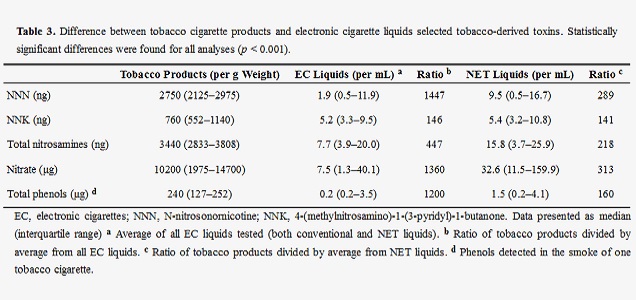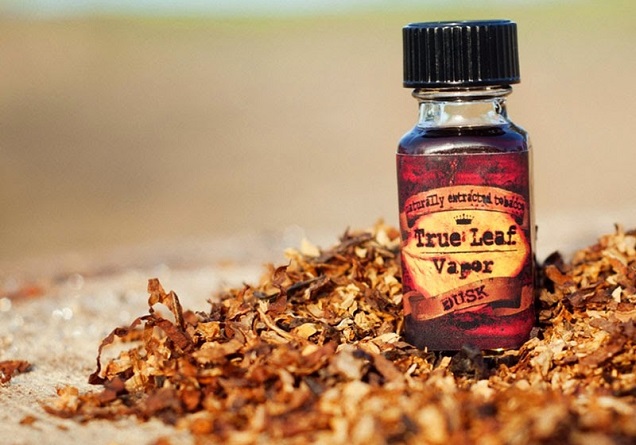
Naturally-extracted tobacco (NET) e-liquid is widely-recommended by those searching for the most realistic tobacco e-liquids, but results from e-liquid chemical and toxicological studies would suggest that they carry slightly greater risks than your average e-liquid. This might be enough to put you off trying a NET blend – in the same way you might be put off vaping juices with diacetyl – but, if you’re looking for a realistic tobacco e-liquid, is the added risk worthwhile? Is it likely to be a particularly big increase in risk? We take a look at the pros and cons of NET e-liquids.
What is a NET E-Liquid?
The basic definition of a NET e-liquid is one that extracts the flavor from real tobacco, steeping chopped or ground tobacco in PG, VG or a mix of the two to allow the natural flavors to make their way into the base mixture. This can be done with the aid of heating – to make the process a little quicker and to offer a stronger flavor – or cold (with no heat added) – which takes longer but preserves more of the complexity and nuance of the flavor.
Do NET E-Liquids Really Taste Much Better?
The short answer to this is: hell yes. For the artificially-produced flavors that attempt to replicate tobacco with no sweet, RY4-esque components to help it go down easier, the flavor often manages to capture some element of the true flavor of tobacco, but it’s often a sort of musty, sweaty feet type flavor that doesn’t quite get the job done. This is why most vapers quickly move away from tobacco e-liquids: most of the time, they pretty much suck.
NETs, on the other hand, often manage to capture the taste of fresh tobacco remarkably well. Note the use of the word “fresh,” though. The flavor of combusted tobacco is another story: this comes – in part – from the ton of combustion products, carcinogens and other nasties you inhale when you burn tobacco, and no e-liquid, NET or otherwise, will ever really be able to accomplish this. NETs offer an authentic flavor, but a clean authentic flavor, often described as being like the aroma of fresh tobacco – a freshly-opened pack of cigarettes or a scoop of pipe tobacco, for example – rather than the taste of smoking. That said; they’re likely the closest you can get to the taste of smoking in e-liquid form.
The Added Risks of NETs – Are They Really That Bad?
However, since tobacco is bad for you, it stands to reason that the extraction process for NET e-liquids would mean it wouldn’t produce the safest e-liquids to vape. Although research is pretty limited, we do have some suggestions of what the risks from NETs are likely to be in comparison to smoking tobacco and ordinary e-liquid.
A recent study from Dr. Farsalinos looked at the chemical composition of 11 NET e-liquids in comparison to 10 ordinary tobacco e-liquids and tobacco itself, and generally found that NET e-liquids do contain more tobacco-derived toxins than ordinary tobacco e-liquids, suggesting that the risk would be slightly higher. However, the key comparison for many – especially if you’re looking to quit smoking using NET e-liquids – is between the e-liquid and actual tobacco.

In comparison to tobacco, both types of e-liquid provide vast reductions in exposure to harmful chemicals. Nitrosamines are carcinogens, and the study (looking specifically at NNN and NNK, the two that pose the biggest risk) found that per gram of tobacco, there are 3,440 nanograms (billionths of a gram) in total of these nitrosamines. In ordinary e-liquid, there are just 6.1 nanograms per ml, about 564 times less than in tobacco. For NET e-liquids, the total nitrosamine content is 15.8 ng per ml, or 218 times less than tobacco. For vapers choosing between NET e-liquids and conventional tobacco-flavor e-liquids, this means that NETs contain about 2.6 times more nitrosamines than conventional options.
For the other chemicals covered in the study, the picture is much the same. Levels of nitrates in NET e-liquids are 313 times lower than levels found in tobacco, but ordinary e-liquids contain even less than NETs (ordinarily below detectable levels), and for phenols, NETs contain about 160 times less than tobacco (expected to be highest when heat-assisted extraction is used), but ordinary e-liquids contain even lower levels (again, normally below detectable levels).
The other study addressing NET e-liquids looked at their effects on cultured cells, and the findings generally run along the same lines: NET e-liquids are safer than tobacco by a substantial margin, but ordinary e-liquids are safer than NETs. The study looked at the toxicity of the vapor from 20 e-liquids on cells, with four NETs in the bunch. Three of the four NET e-liquids showed toxicity to cells at concentrations of 50 percent or higher, but of the other e-liquids, only a cinnamon-based liquid showed toxicity in undiluted form. In comparison, tobacco smoke was toxic to cells at concentrations of 12.5 percent or higher. Again, while NET e-liquids seem riskier than non-NET blends, the risk in comparison to tobacco is clearly reduced by a significant margin. However, it’s worth noting that one of the NET e-liquids exhibited more toxicity than the cigarette smoke when completely undiluted.
NET E-Liquids: The Taste vs. The Risk

So the question is: is the increase in risk in comparison to other e-liquids worth the realistic tobacco flavor provided by NET juices? This is something you can only really answer for yourself, but it’s important to maintain some perspective. For anybody using NET e-liquids to help them quit or reduce their smoking (especially if it’s the only thing that really works for you), the answer is obvious: you’re much better off vaping a NET e-liquid than smoking tobacco.
For already-converted vapers, the question is a lot thornier, but the benefits in comparison to smoking are still important. Much like with the diacetyl scare, the question comes down to how much you’re worried about a likely very minor increase in risk in comparison to other e-liquids. If you really want to avoid risk as much as possible, quitting vaping altogether would undoubtedly be the best way to go. No matter how you cut it, from an absolute risk perspective, the real way to minimize the risk you’re exposed to is to not inhale anything that isn’t air.
However, that argument doesn’t hold much weight if you still want to enjoy nicotine but just want to do it as safely as possible. In this case, the answer is that NET e-liquids probably aren’t the best idea if you won’t mind missing out on them. Granted, there have only been two tests, but the comparison between ordinary e-liquid and NET e-liquid has come out the same both times: NET e-liquids are riskier.
Personally, while I would prefer to avoid unnecessary risk, I’ll happily vape NET e-liquids with little concern. I’m not saying this is the right choice for you, but for me, the fact that the levels of tobacco-derived toxins are still hundreds of times lower for NET e-liquids compared to tobacco and that the vapor produced from them is much less toxic than cigarette smoke makes it hard for me to worry too much about the risks.
When I’m in the mood for a tobacco e-liquid – especially since it isn’t an everyday occurrence – the benefits in terms of flavor seem to outweigh the relatively minor increase in risk. If I found a non-NET tobacco juice that tasted as good without relying on copious amounts of sweetness, then I might change my mind, but until then the flavor takes precedence for me. The nitrosamines example gets the point across: ordinary e-liquids contain 0.2 percent of the nitrosamine content of tobacco, NET e-liquids contain about 0.5 percent of the amount in tobacco. Does that 0.3 percent difference really matter that much? It’s not ideal, but I just find it hard to get that worried about it.
Conclusion – For Tobacco-Lovers, NETs Are Worth the Risk
So the risk from NETs is bigger than the risk from most juice, but in comparison to tobacco it’s still likely to be tiny. If you’d miss the taste of tobacco, or if you just want the occasional NET treat, it’s hard to argue that the minor increase in risk is anything to worry too much about. If you’re really concerned about minimizing your risk – but not enough to stop vaping – then it’d probably better to avoid NETs, but otherwise, the still-abundant benefits in comparison to combusted tobacco mean that NETs have more positives than negatives.
See also: Top 10 Must-Vape Tobacco E-Liquids

